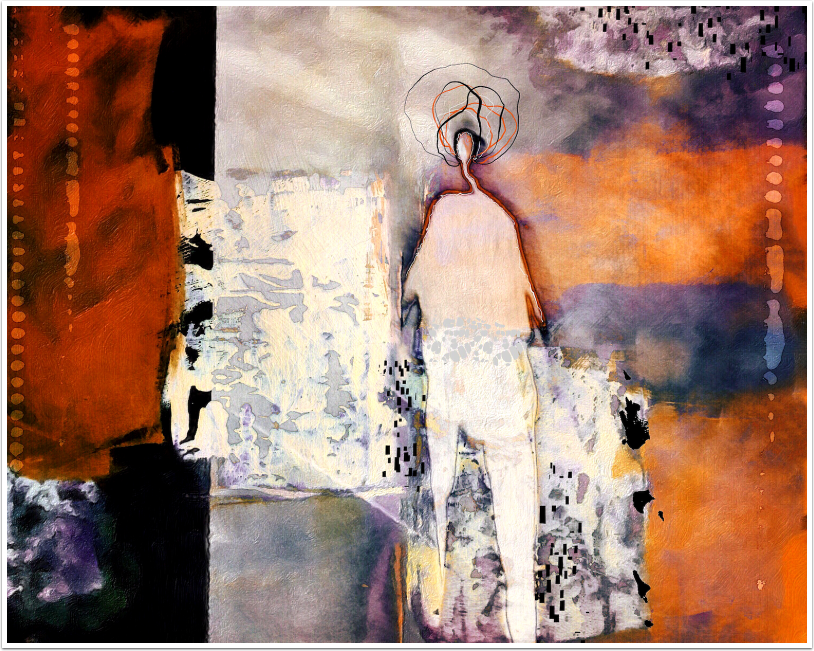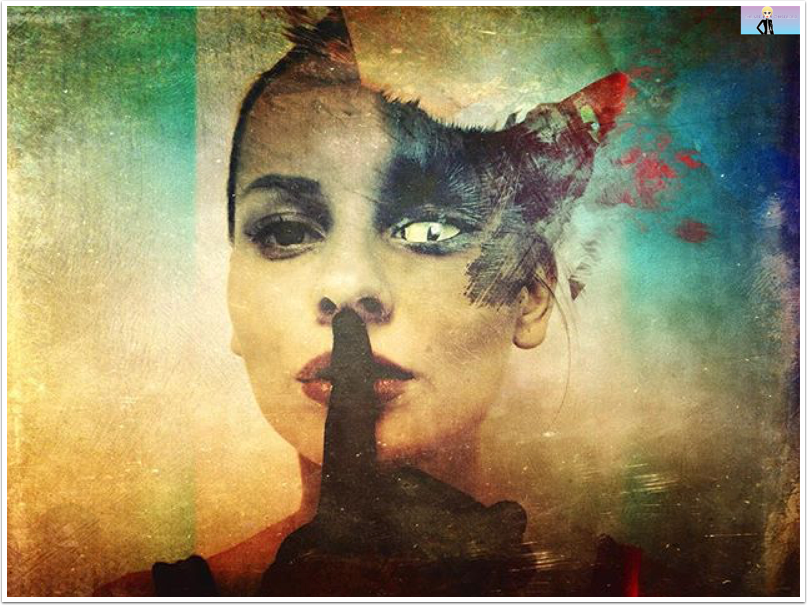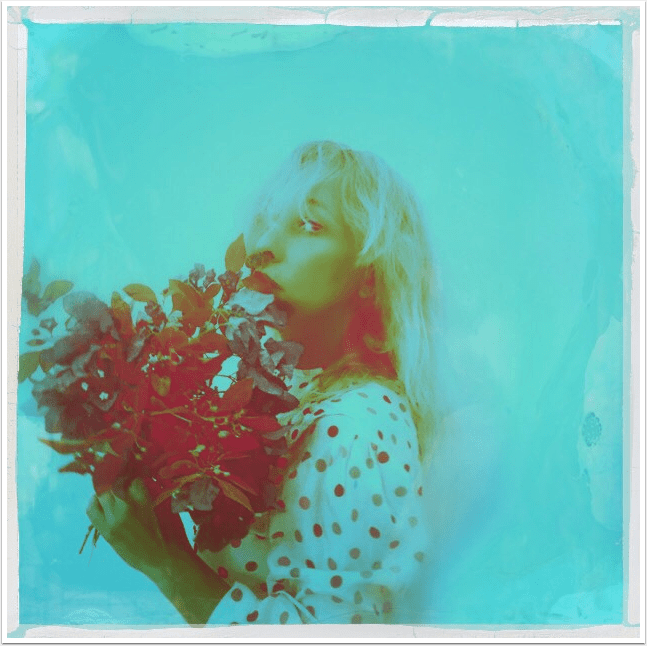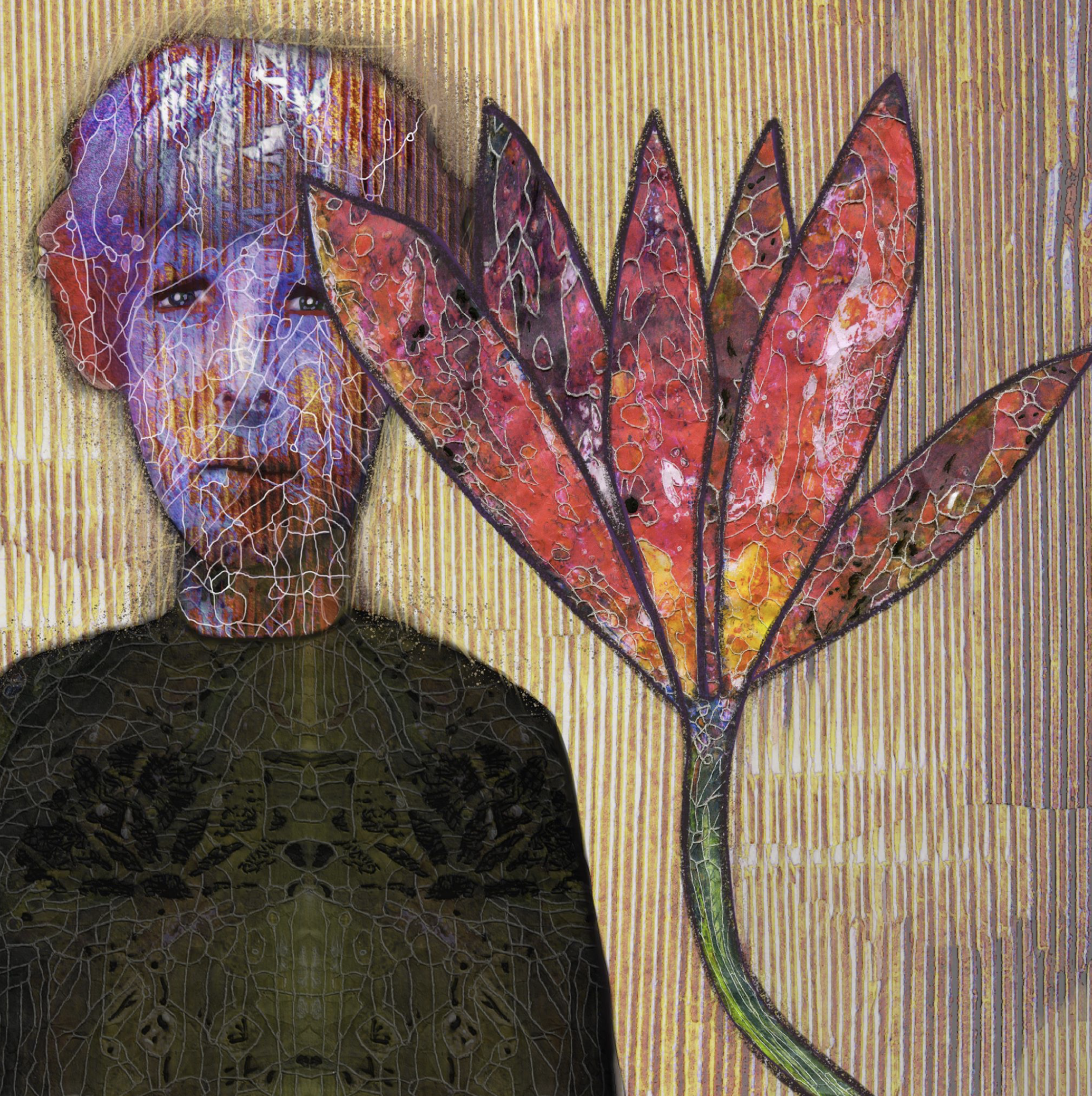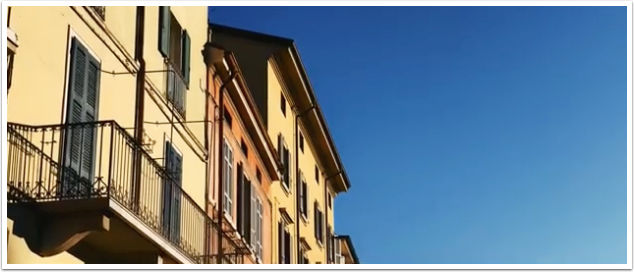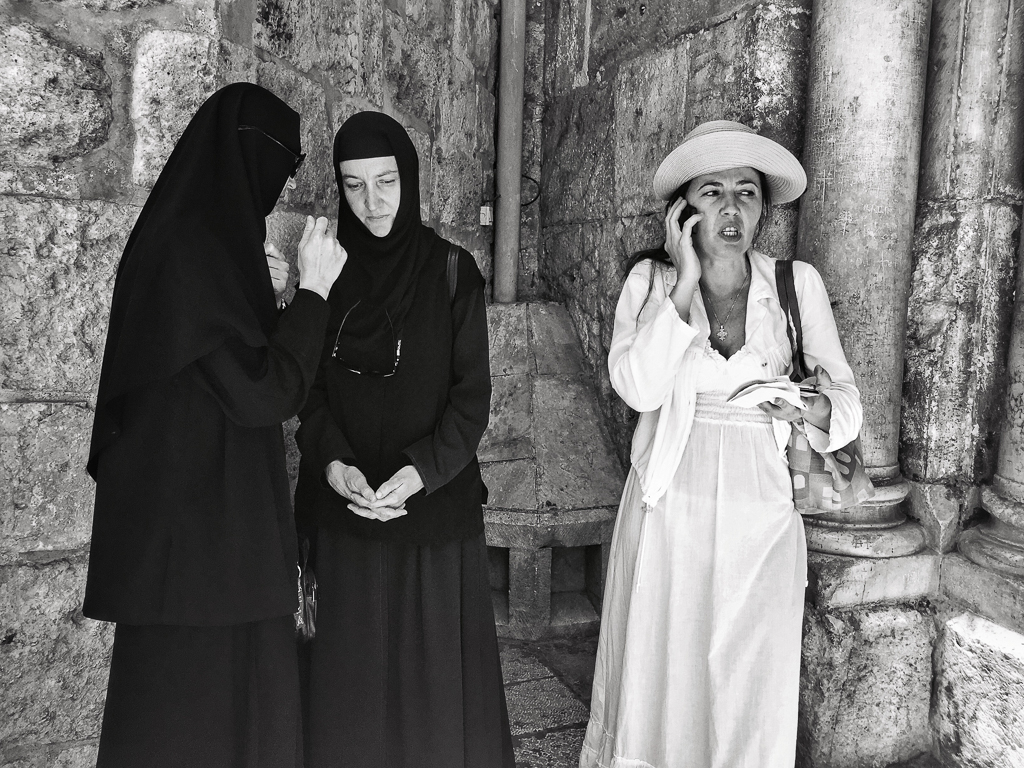
Mobile Photography – Streets Ahead Interview – Karen Axelrad – Mobile Street Photography
This week, the Women’s Mobile Street Photography Collective (StreetsAhead) is pleased and honoured to feature Karen Axelrad in our interview segment by our co-editor of this group, Cara Gallardo Weil. Thank you both for this, our readers are going to love it! (foreword by Joanne Carter).
“I highly recommend a visit to Karen’s gallery on flickr and her instagram account where you will see some of her other work as well as her street photography”.
www.flickr.com/photos/karenaxe/
Selfie at the Belvedere in Vienna ©Karen Axelrad
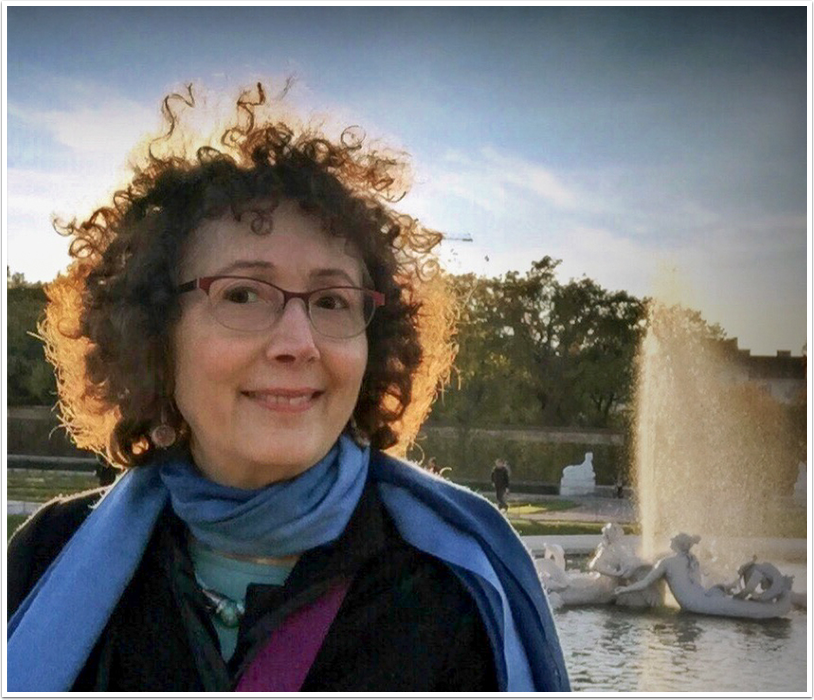
Please tell us a little bit about yourself and what you do. Have you always been interested in photography?
I grew up in Los Angeles. I got seriously interested in photography when I was studying architecture. I am self-taught, but had a darkroom when I came to Germany in which I experimented with black and white photography. I met my German husband while studying architecture at UCLA which is why I ended up in Berlin (after a year in London and studies in Florence). We were partners in an architecture practice called Schiedhelm+Partner. I used a Rollei and a Nikon with shift lens to photograph our buildings for publications. Fast forward many years and I was enthralled with David Hockney’s polaroid photos. So when the first 1mb digital camera came out, I finally had the means to take masses of photos and experiment. When I look back at those first totally digital photos, the quality was less than ideal, but I was hooked. Later I used Canon DSLRs. I participated in an exhibit called U.S.fAcets at Amerikahaus in Berlin in 2008 called “Political Protest” in which I documented American protest in Berlin during the Bush years.
‘All Lives Matter’ ©Karen Axelrad
At the #nobannowall demonstration. Hipstamatic, JohnS, BlacKeys SuperGrain.
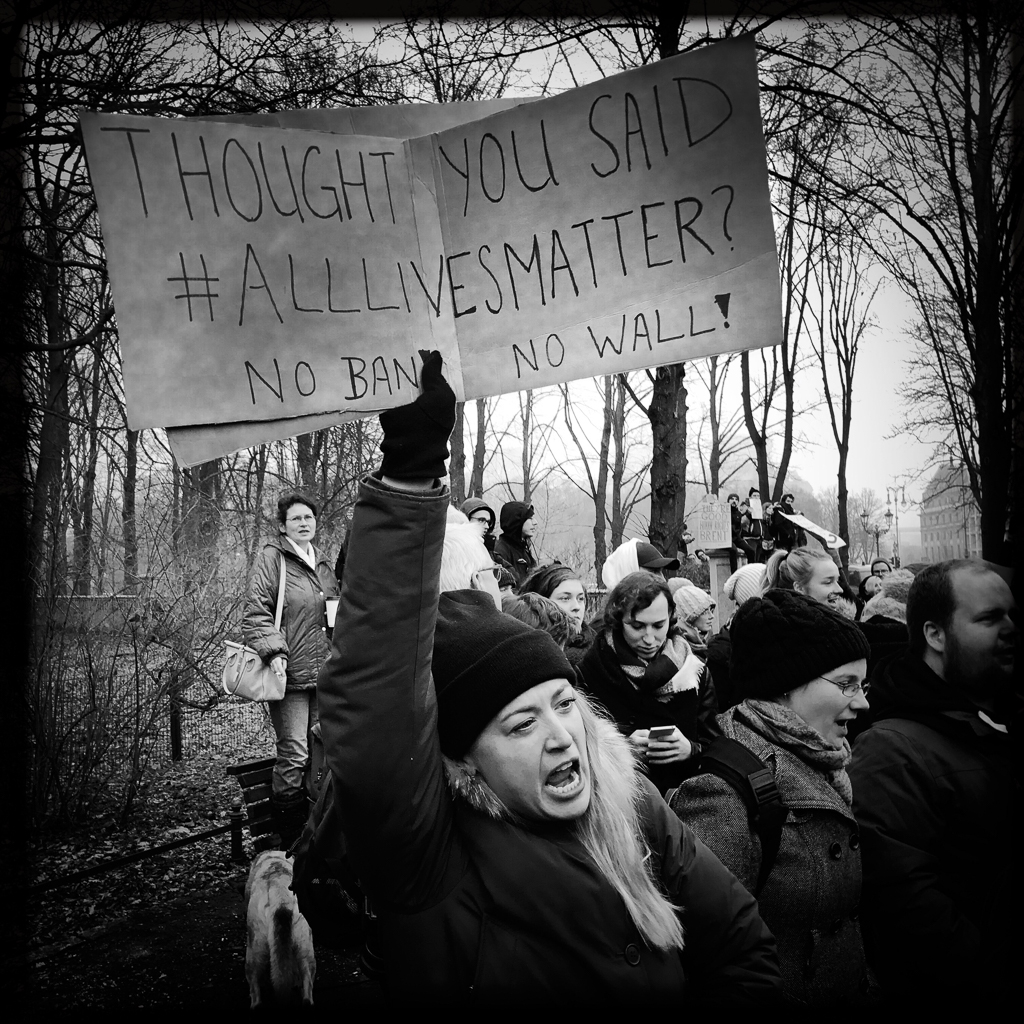
Where do you currently live? Is this a place that gives you energy and inspiration for your street photography or do you have to travel to find it?
I am retired, but still live in Berlin which has become an exciting international city with a vibrant art scene. There are multitudes of photo opportunities here, but I always photograph when travelling too.
‘Men’s Eyes Reflected on Muslim Women’s Dress’ ©Karen Axelrad
At the Jewish Museum in Berlin. Hipstamatic, John S lens, BlacKeys XF film
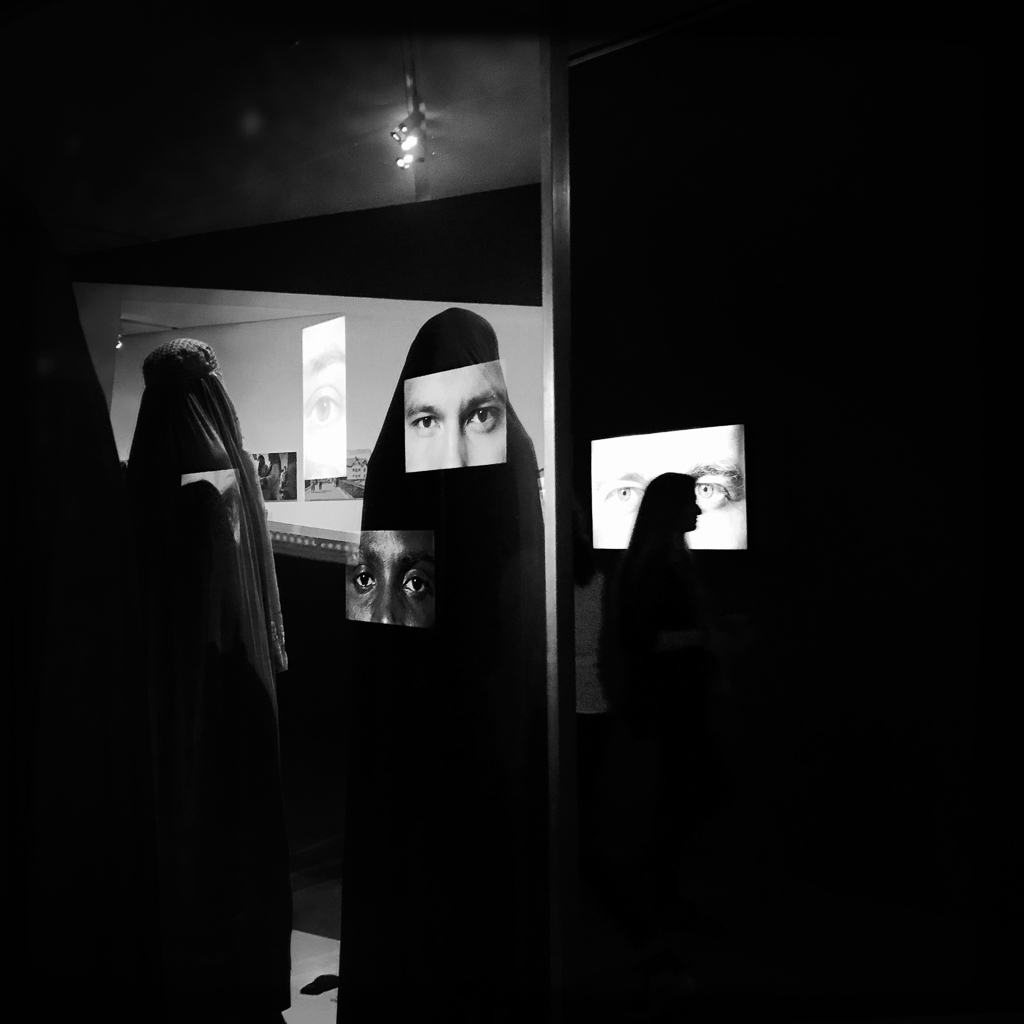
Does your location, be it a big city, a small town, or the countryside, heavily inform all your photographs in general, not just your street photographs? How do you choose the places that you go to photograph?
I can’t say that I have a favourite place to photograph. I photograph in the subway or at art exhibits, but I am always looking for photo opportunities and Berlin has plenty.
‘Kick it Like’ © Karen Axelrad
Hipstamatic, John S lens, BlacKeys SuperGrain film, Triple Crown flash.
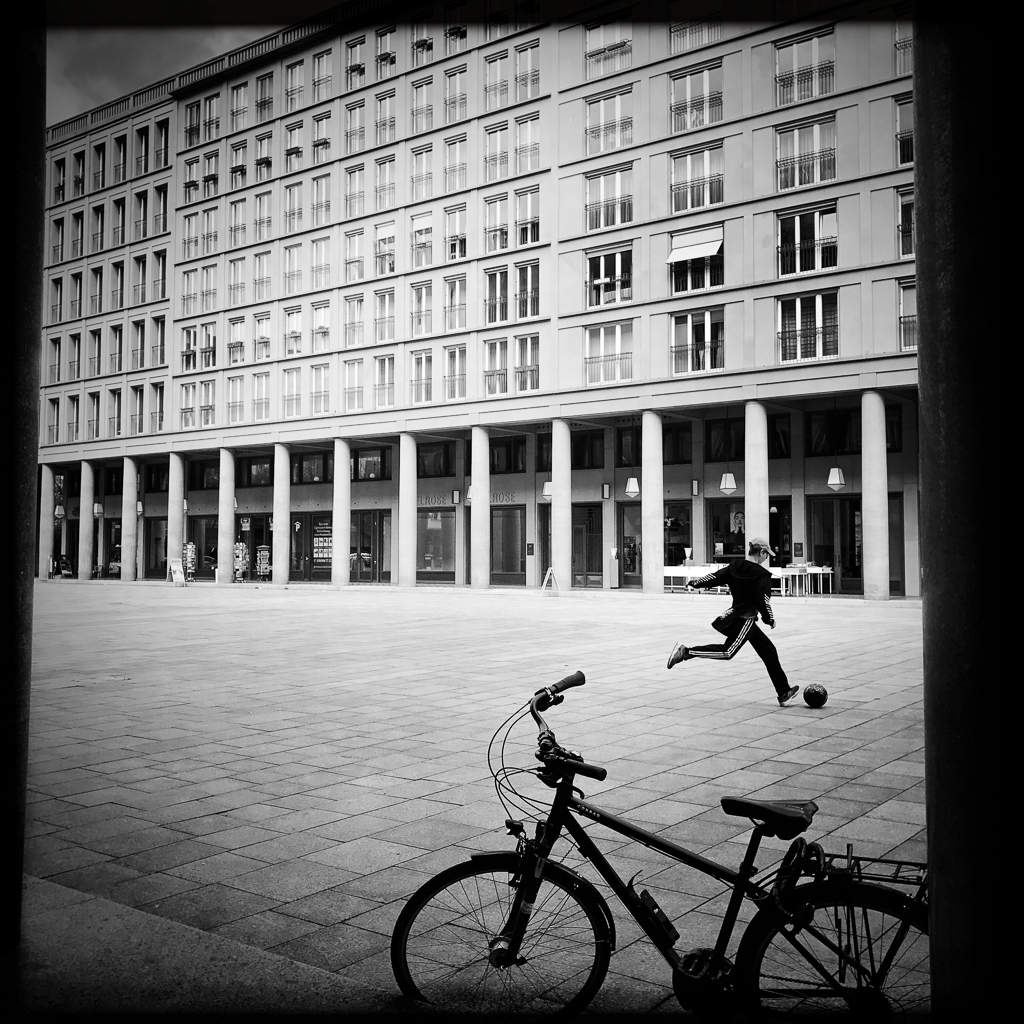
What first drew you to street photography and how did you discover it? What is it about street photography that compels you go out to shoot on the street? What are the subjects that are of the greatest interest to you?
I am basically shy about intruding. I was used to photographing buildings and cityscapes, but the iPhone opened the possibility of being more anonymous. I started with parades and moved from that to more ordinary scenes of people. I suppose what compels me now is the search for that great once-in-a-lifetime photo. But the stimulation from the act of seeking is enough reason to go out shooting.
‘Legs’ © Karen Axelrad
Shot with Hipstamatic JohnS lens, BlacKeys B+W film, Standard flash, and Snapseed
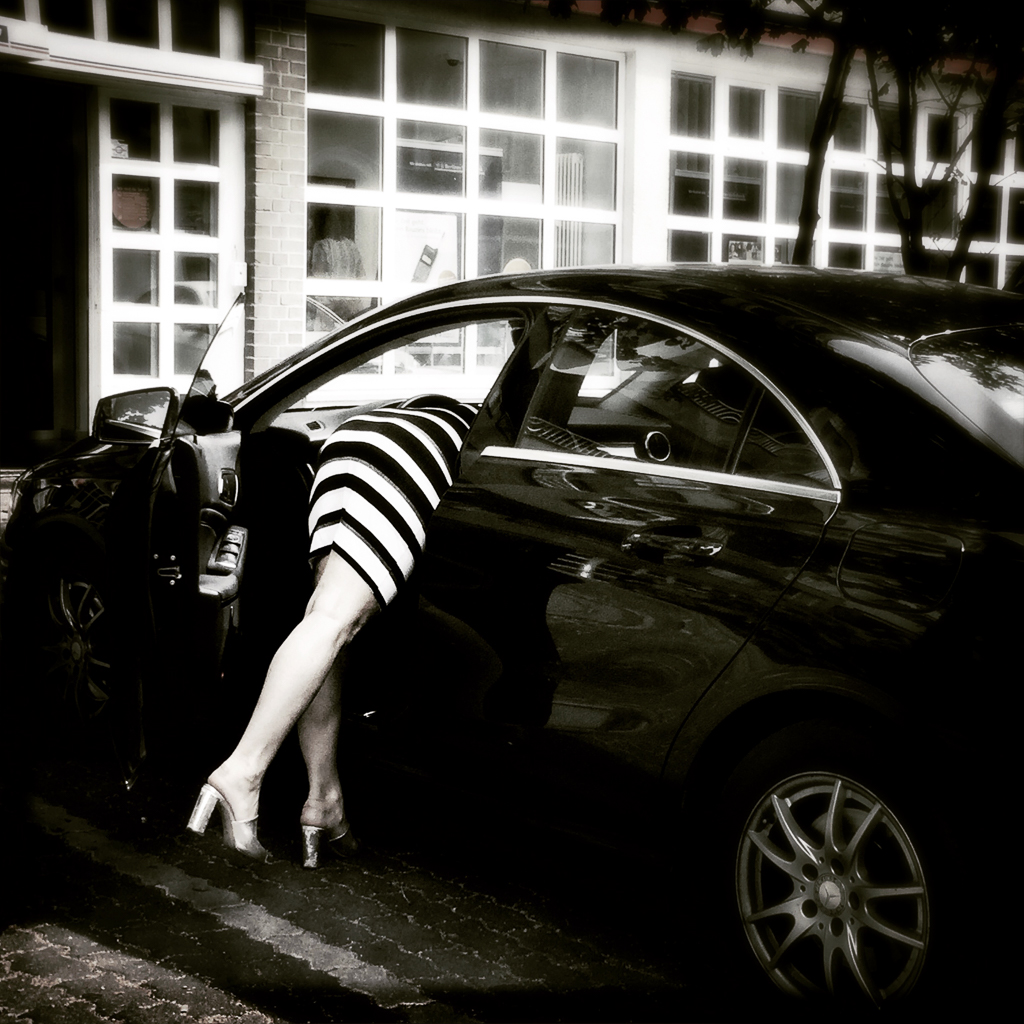
Do you sometimes secretly pose or direct the subjects in your shots or do you always shoot spontaneously? Do you think there is a “right” way to take a street photograph? There are those who feel that a photograph is only good if it follows certain guidelines and fundamentals such as “the decisive moment” or that street photography should never be posed. How do you feel about this?
I have no rules. I surreptitiously photograph people without their knowledge using a Bluetooth remote or a selfie stick (they think I’m taking a selfie and smile when they walk by). Rarely, I’ll ask a stranger to photograph them and move a bit to catch the light.
‘Assembly’ © Karen Axelrad
Snapseed, Nova (was Ansel), PhotoshopFix, in Jerusalem
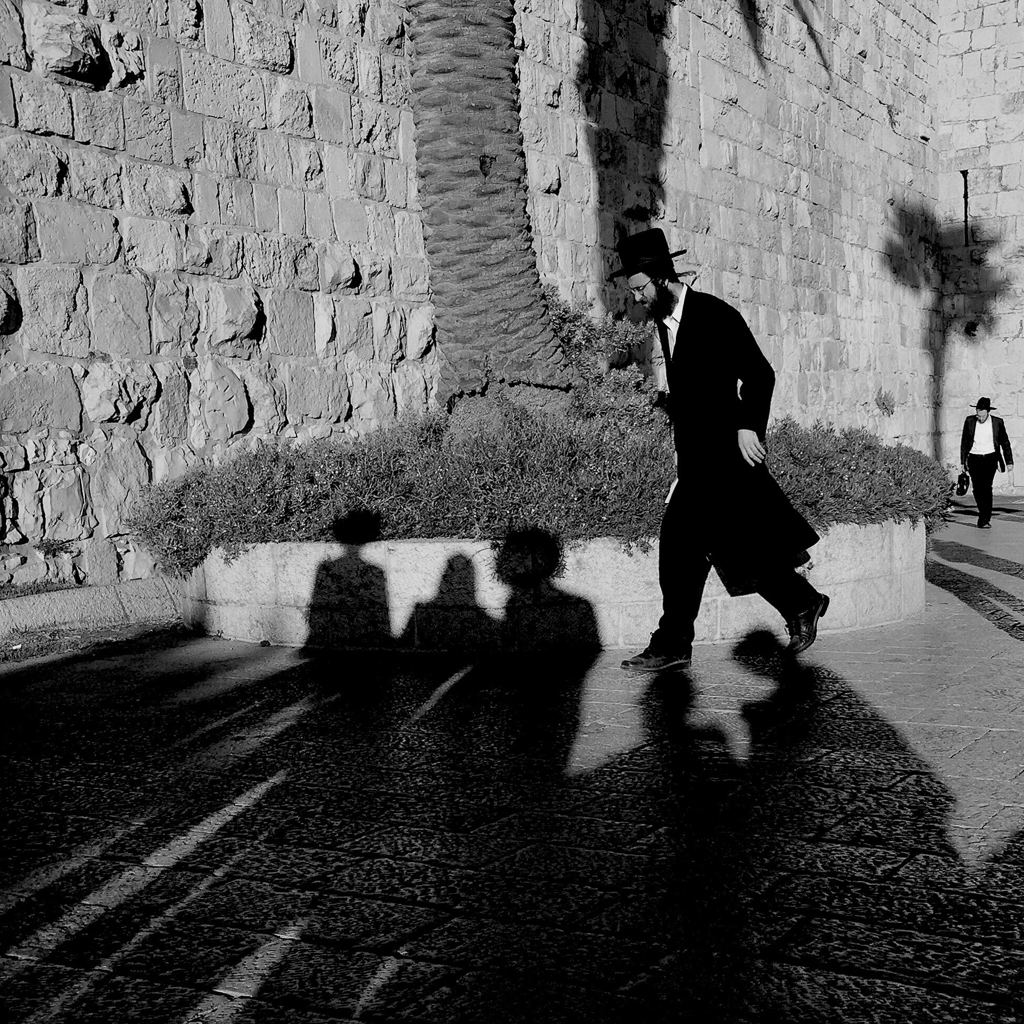
How do you feel about shooting from the hip as opposed to looking though the viewfinder?
I sometimes try to shoot from the hip but it often doesn’t work. At times I set up my iPhone on a mini-tripod and then shoot with my remote as people walk by. My preferred method of shooting is on a mini tripod (even hand-held adds stabilisation) or selfie stick with a Bluetooth remote so it isn’t obvious when I am taking a photo.
‘Waiting’ © Karen Axelrad
Snapseed, Superimpose, Photogene (at LACMA in Los Angeles)
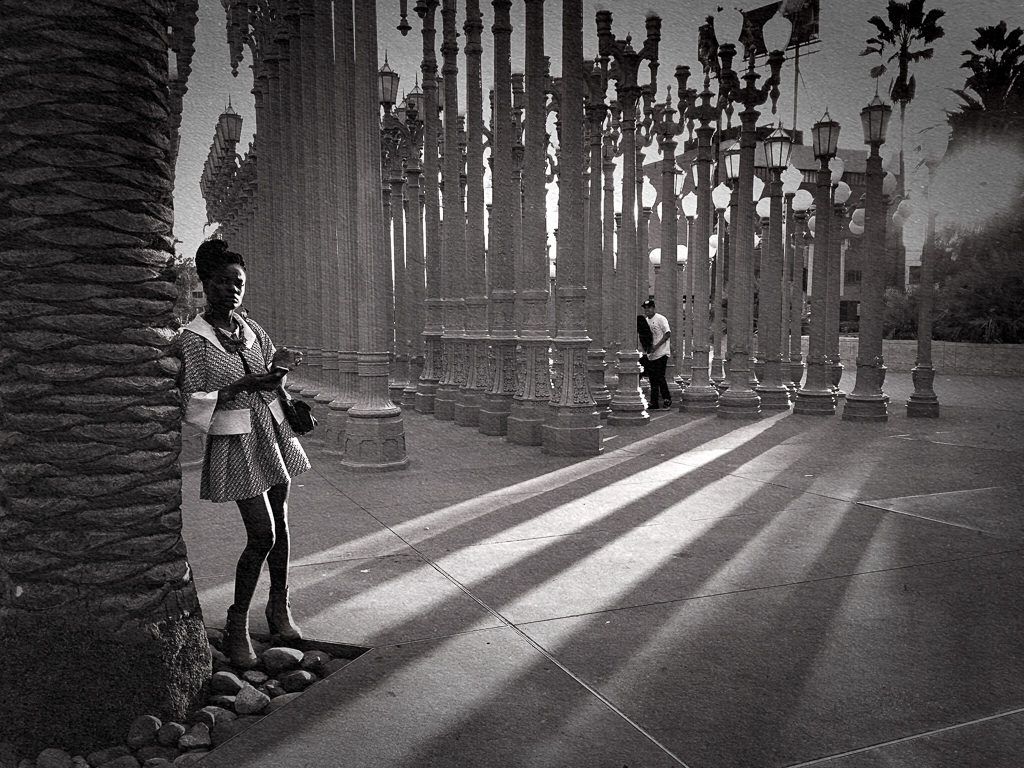
These days, the genre raises many questions with regards to the morals and ethics of taking photographs of strangers in a public environment. It is becoming increasingly difficult to shoot freely as a street photographer. What are your thoughts on this?
I am very torn about this subject. If I photograph a child, I usually make sure that the parent knows I have taken a photo, and even if I knew the child’s name, I wouldn’t publicise it. I find that taking silhouettes or long exposures in which the faces are blurred removes me from copyright dilemmas. If I take a series of photos with someone’s permission, I will try to email the photos to them. But there is also that gray area of photographing strangers without their permission, and I have done that too.
‘Seeking the Hypotenuse’ © Karen Axelrad
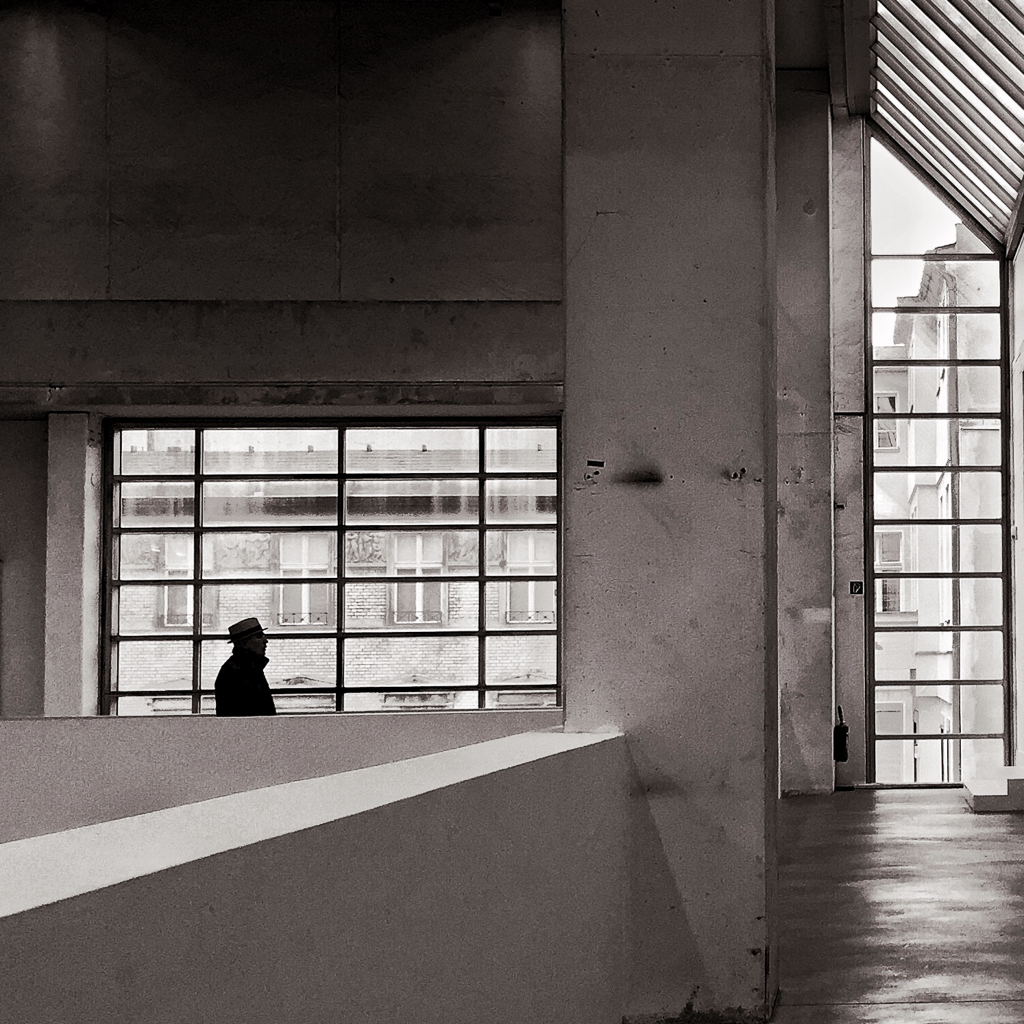
How do you feel about using model release forms and re-publication of images of the public? Are we morally, if not legally responsible?
I haven’t used model release forms yet, although it is a good idea. If I have a recognisable person in a photo, it would be difficult to enter that photo in a print contest. Though I feel uncomfortable photographing people without their knowledge or permission, I am guilty of doing it occasionally. I eliminated some photos to show here, because the people were too recognisable.
‘Sunday Jogger’ © Karen Axelrad
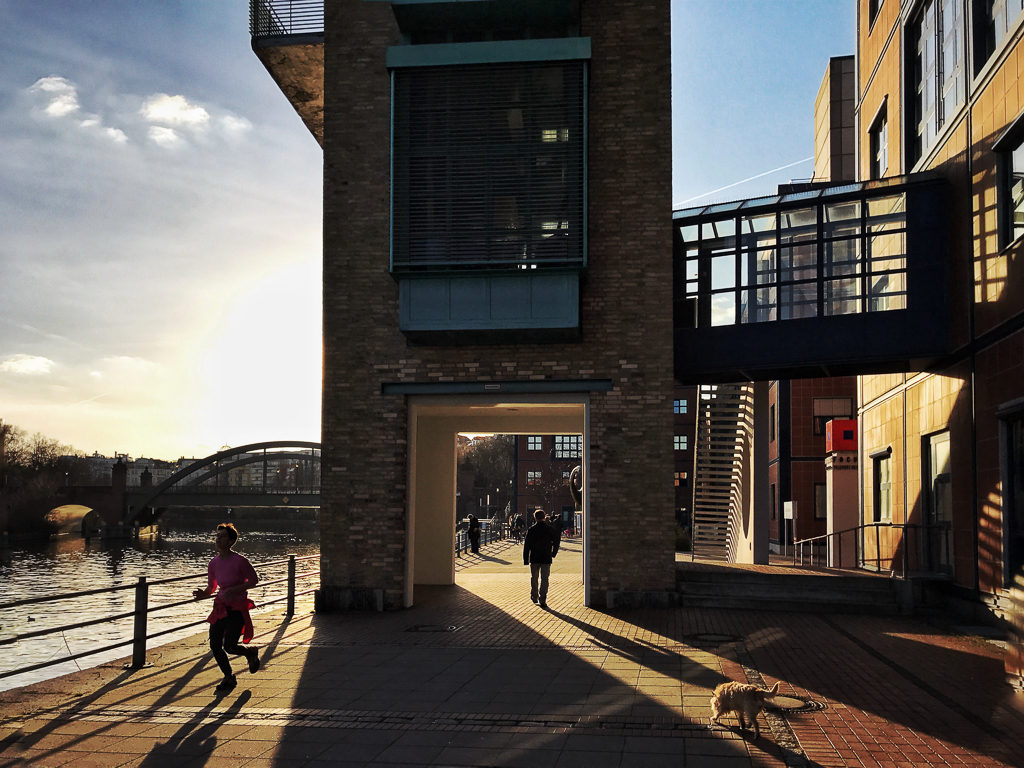
Do you have any personal rules when it comes to street photography? For instance, are there any situations that you feel are morally unacceptable?
I won’t photograph extremely physically handicapped people for a street photo unless they are in a protest march and there is a reason to photograph them. I also try to avoid beggars.
‘On the Job’ © Karen Axelrad
This photo was taken with the ProCamera app at the Alte Nationalgalerie in Berlin and was processed with more apps than I would probably use today: Snapseed, Dramatic HD, Fixel, Photo Toaster, and TouchRetouch. It was straightened and something slight was removed to add clarity.
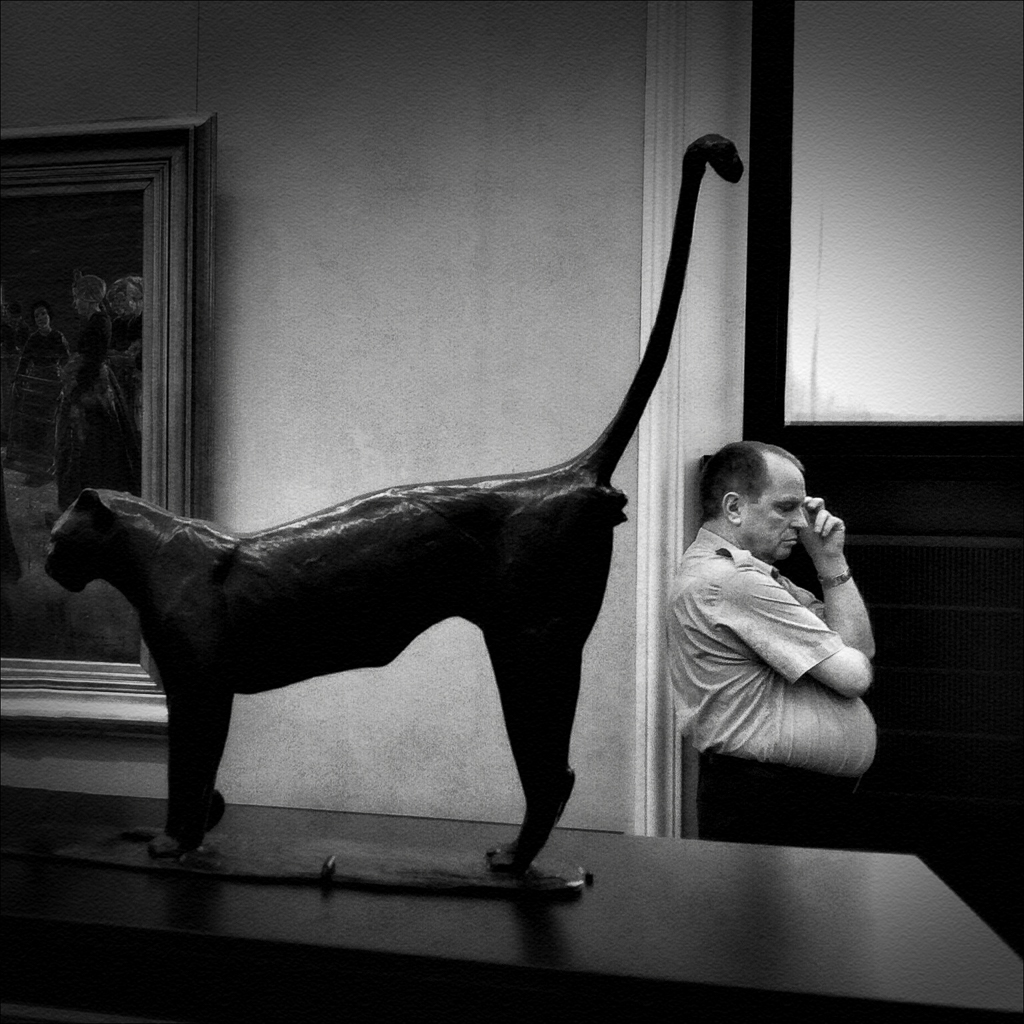
Do you think women street photographers share a different perspective to men? If so, can you elaborate on your thoughts?
I personally don’t see a strong difference in street photography. Often I think it is much easier to identify a female iPhoneographer who is doing original art work.
‘Confusion’ © Karen Axelrad
Apps used: Snapseed, Stackablesapp. The alphabet on the ground is an artwork in front of the Berlinische Galerie in Berlin. I added sepia and a vignette to add to the mystery.
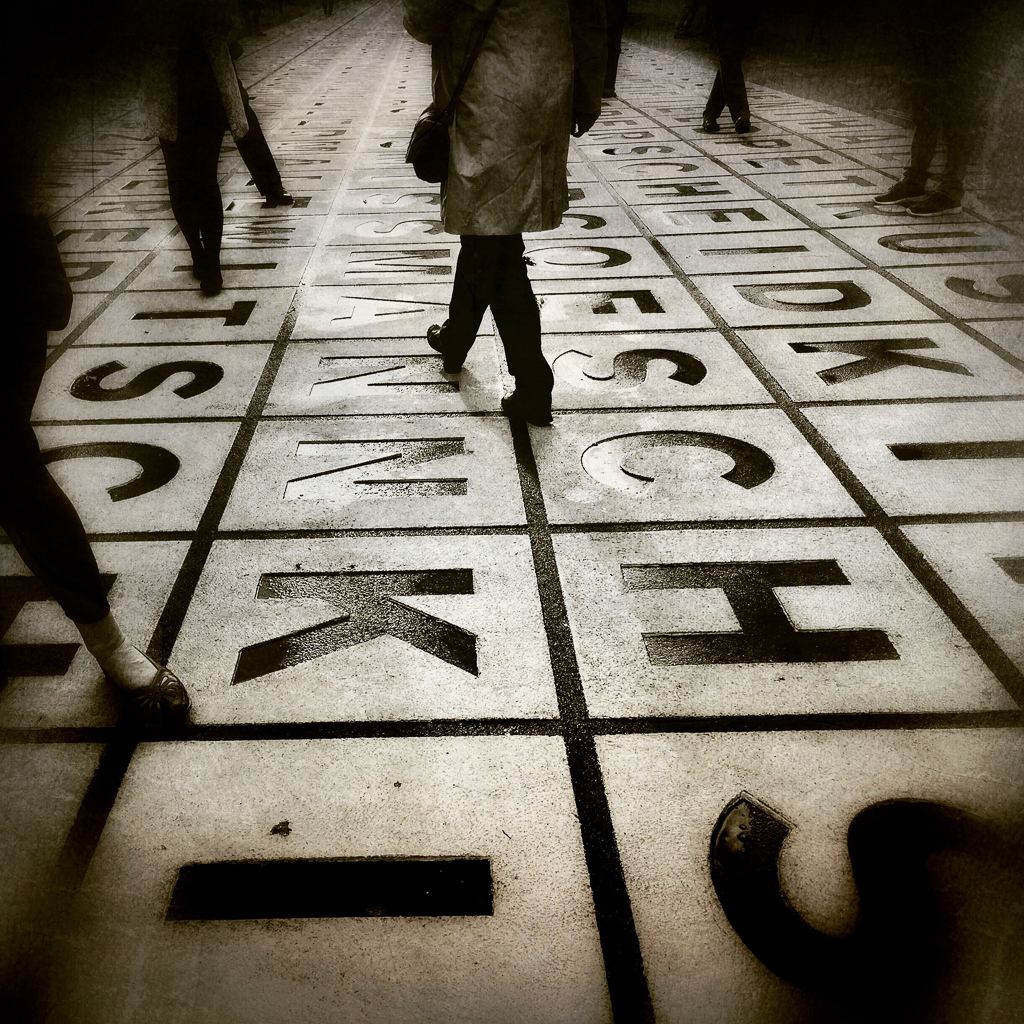
As a woman street photographer, do you find yourself drawn to shooting other women and children or do you prefer to shoot men or is this irrelevant? Would you feel uncomfortable if a male street photographer were to take a photograph of you?
I look for interesting characters and good light. Sex or age doesn’t matter. I don’t think I would feel uncomfortable if a male photographer took a photo of me, though I prefer to be behind the lens.
‘Time is like a Repetitive Circle’ © Karen Axelrad
This was taken using the Slow Shutter app at the Hamburger Bahnhof museum in Berlin. This is one of my favourite apps to use at art museums one gets a sense of movement by the blurred figures, but it takes patience to get just the right amount of blur and a steady hand or tripod to keep the background sharp. It was processed using Snapseed, Photogene and PhotoshopFix.
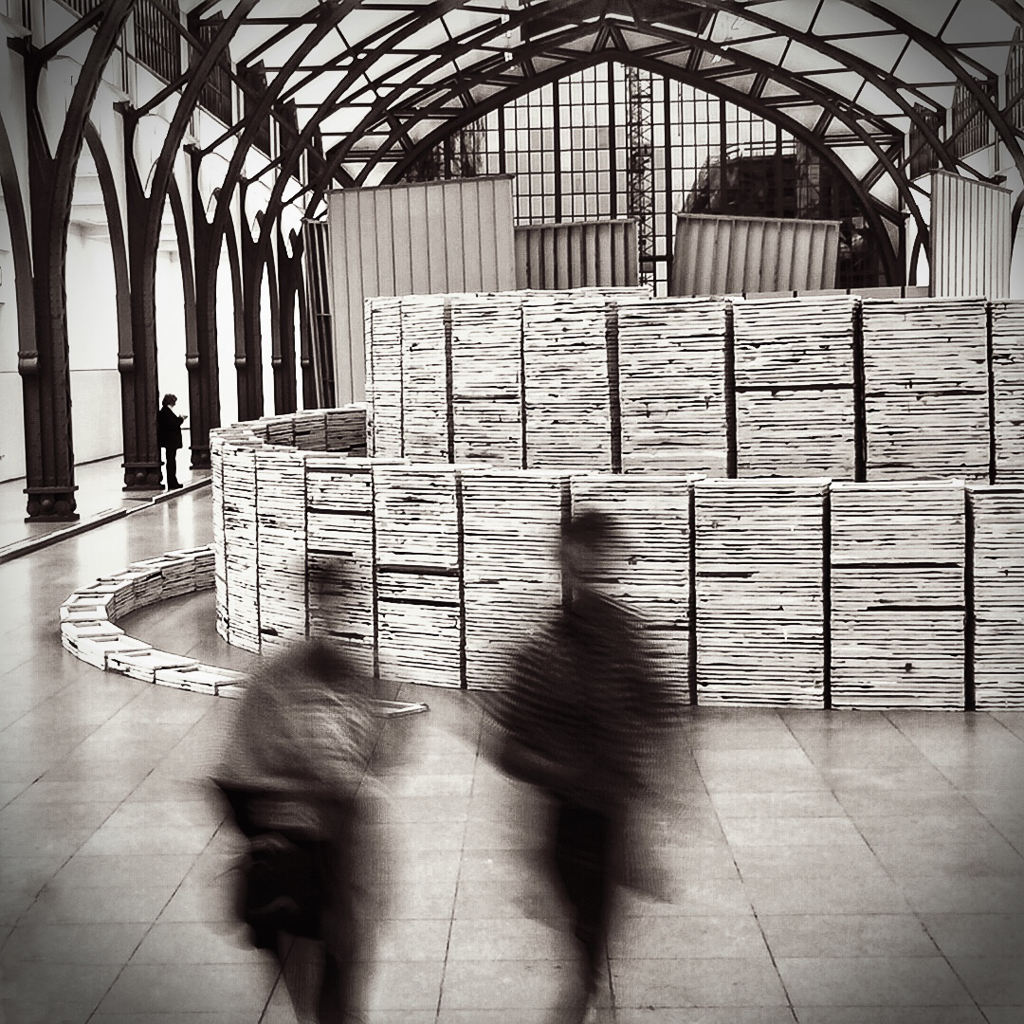
Do you think women street photographers are more accepted by the public when taking photographs or do you think they are more likely to be challenged? Do you have any experience of this?
I have been challenged, and I will erase the photo if it bothers someone. But I doubt that the sex of the photographer makes a difference.
‘Anomaly’ © Karen Axelrad
This was taken as I exited the Church of the Holy Sepulchre in Jerusalem. I love the dichotomy between the calm, devout nuns and the hectic woman speaking on her mobile phone. She is dressed decently, with a long dress, long sleeves, and a hat, but her underwear is showing through. The contrast in attitude and black vs white make this one of my favourite photos. Processing was done in Snapseed.
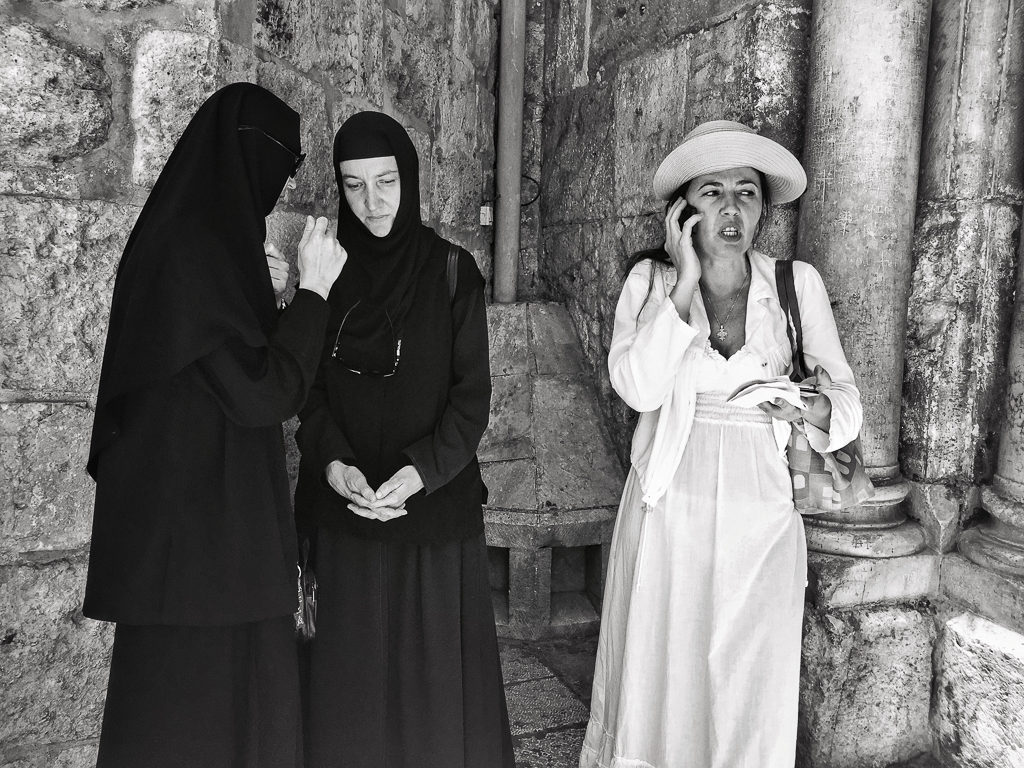
Which street photographers have influenced you?
I think my biggest influence was probably Life Magazine in the late 50s and early 60s. My parents subscribed and I read it cover to cover. So my answer would be the great Magnum photographers.
‘Stair Reflections’ © Karen Axelrad
This is a Hipstamatic photo using Neville lens, AO BW film and Triple Crown flash taken on the stairway at the Uniglo store in Berlin. I waited until I got just the right reflection.
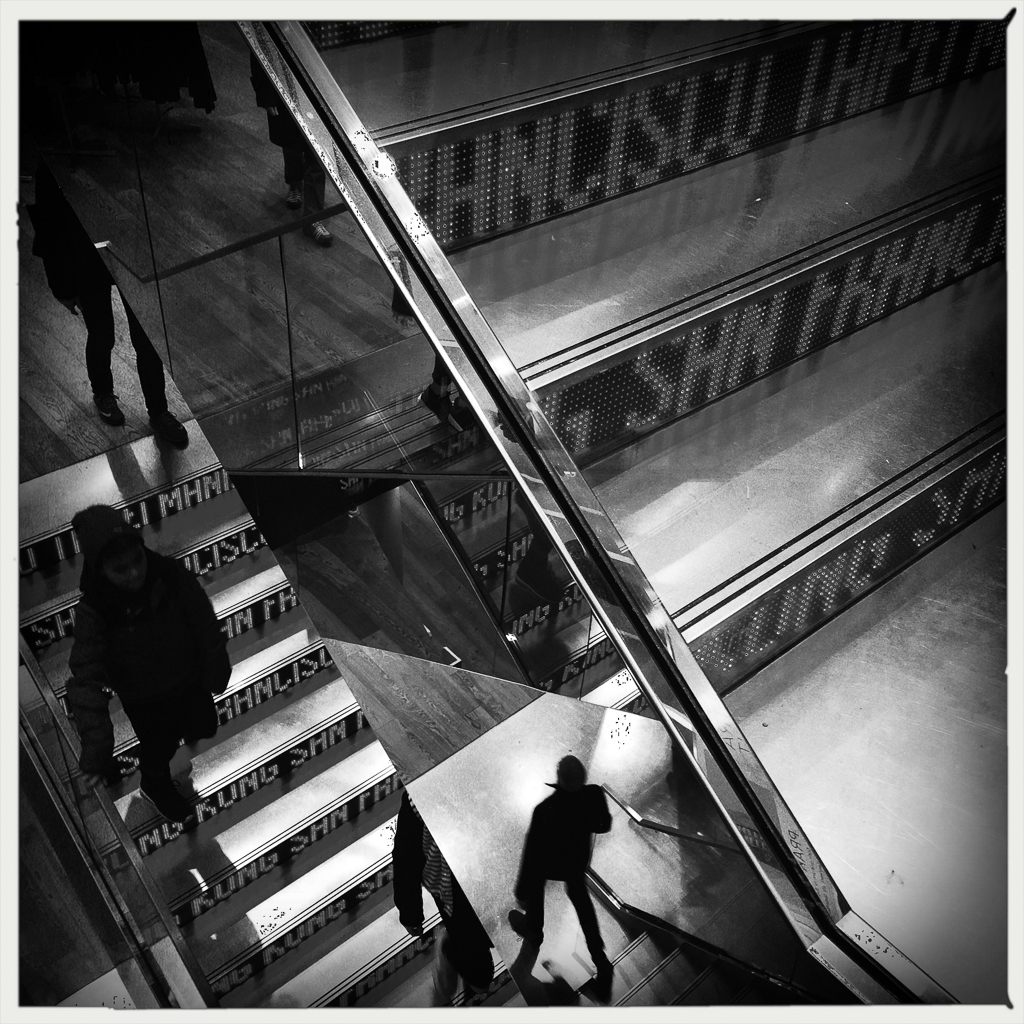
Which mobile device do you use to take your photographs? Do you post-process your photographs? If so, what are your favourite post-processing techniques/apps? If you post-process on your mobile device, do you usually transfer the images as soon as they have been processed to social sites (in other words, capturing and editing the image while in situ) or do you prefer to have more time to work on your images? Please share some examples of your workflow process.
I am using an iPhone 7 now. I immediately transfer my photos from the iPhone to the iPad. I always post-process my photos with the exception of Hipstamatic, and though I have many apps, I often start with Snapseed. I like black and white with strong contrasts for street photography. Sometimes I start with Nova (formerly Ansel) as one can preview the entire camera roll in black and white. After Snapseed, I like iColorama to make subtle changes, and sometimes stackablesapp to finish. I don’t do as much post-processing on street photos as I do with other kinds of photos. When I am finished, I use a template in Photogene to add IPTC information and keyword the apps I used. I either make sure the GPS information is there, or I remove it for privacy. Sometimes I do a little tweaking in Photogene as it is an excellent processing app. I export from Photogene directly to Instagram and flickr. Unfortunately, it doesn’t look like Photogene will be upgraded which means it won’t work with the next version of IOS. If I have taken a lot of photos, it can take weeks or even months before I have processed the best ones. Since the newer version of Hipstamatic came out, I have been using it a lot for street photography.
‘Urban Geometry’ © Karen Axelrad
Another Hipstamatic photo using John S lens, BlacKeys SuperGrain film, and TripleCrown flash taken at Galeries Lafayette in Berlin. This is one of my favourite combos for street photography.
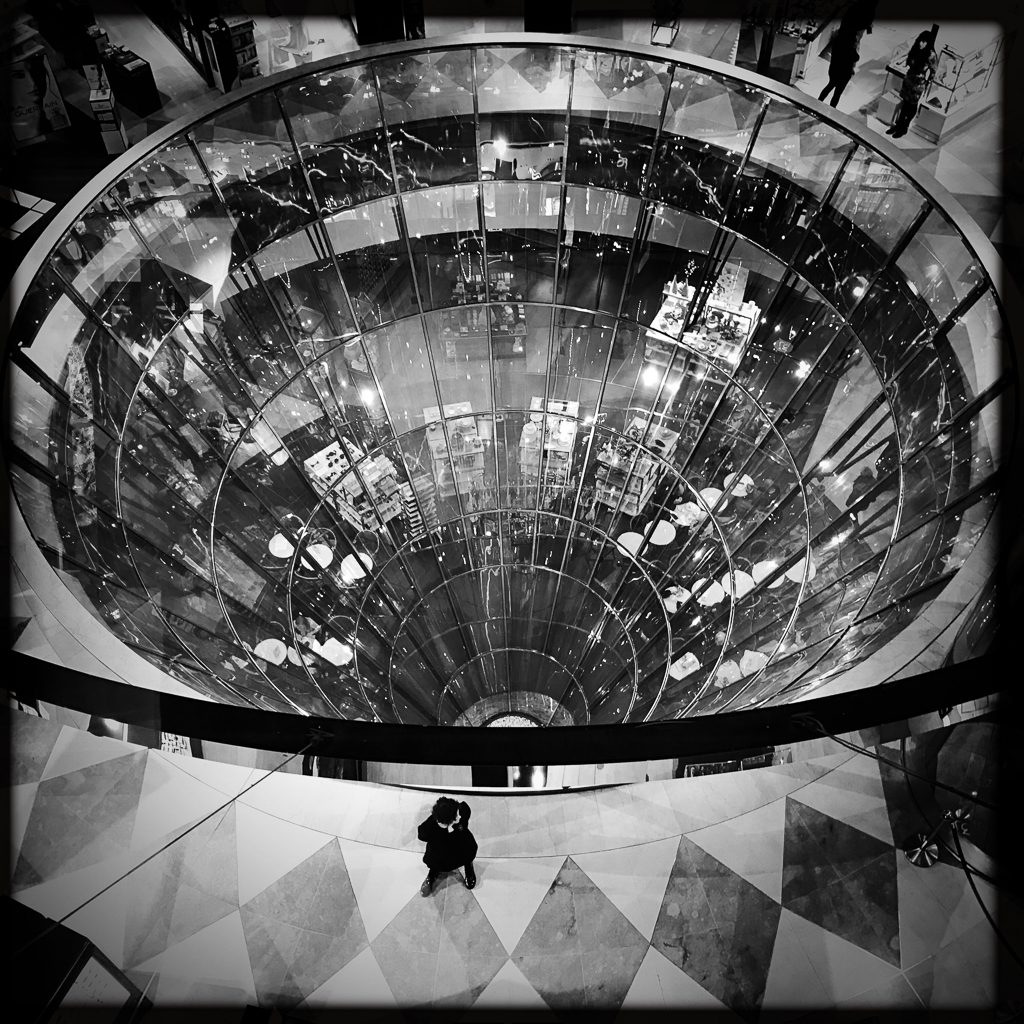
Do you pre-meditate the capture of your images? Do you have a plan or structure in place or do you prefer to act spontaneously? Please share your thoughts about some of your images what you were thinking, or felt when you shot those photographs.
I do both shoot spontaneously when the situation arises and premeditate. When taking slow shutter images, I will stand in one spot and shoot for a long time until I get the right figure in the right place or a distortion that I like. If I see a situation with beautiful light, I will wait a long time for someone to come by and fill that space. In a hurry, I’ll just quickly shoot and hope I got something.
‘Shoot the Moon’ © Karen Axelrad
This was taken in Venice, California and processed with Snapseed. I took many photos until I got the football in the right position.
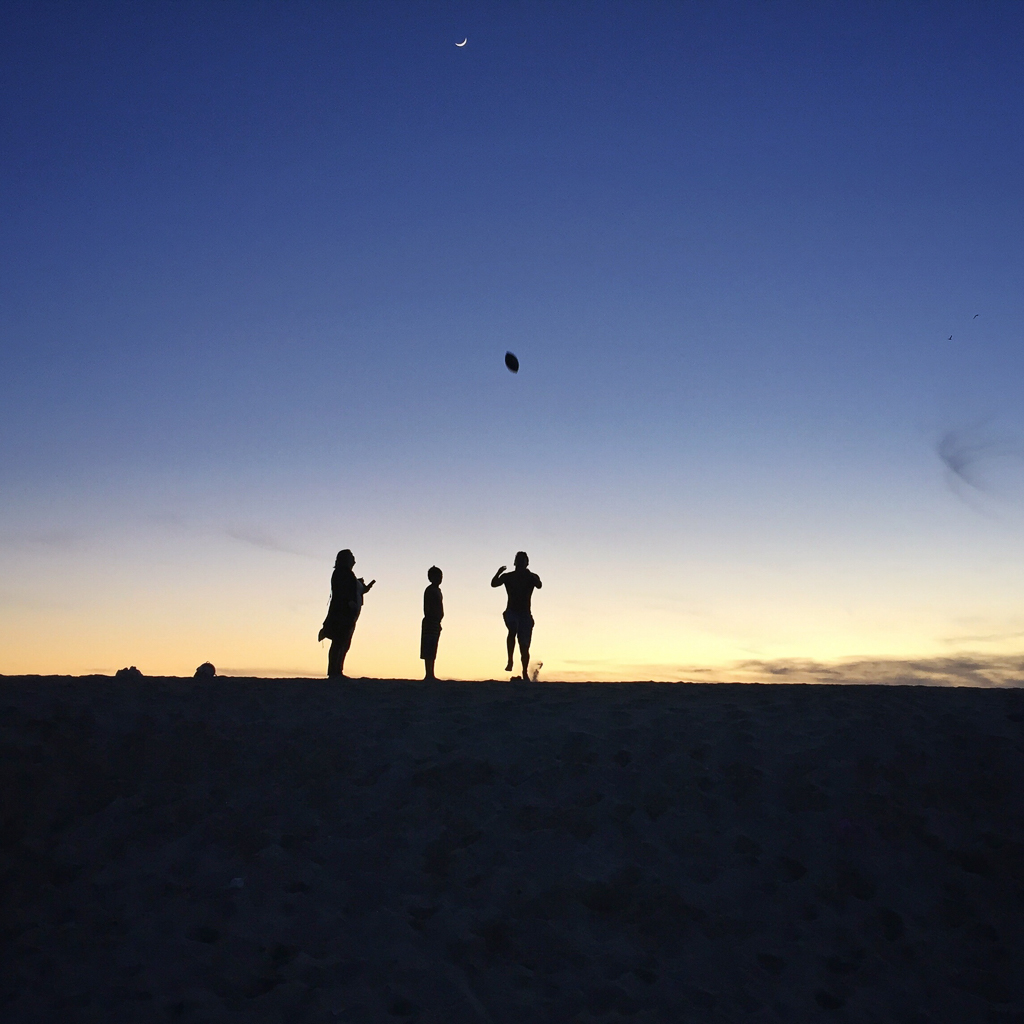
What is the importance of street photography within the entire body of your work? To what extent is street photography a major focus for you?
I am still experimenting with many types of mobile photography, but I think my street photos are my best and often the ones that have the most resonance.
‘Jump’ © Karen Axelrad
Again, I took many photos until I got the right amount of action. This was processed in Nova (formerly called Ansel). In this case, I got the email of the people and sent them the photos
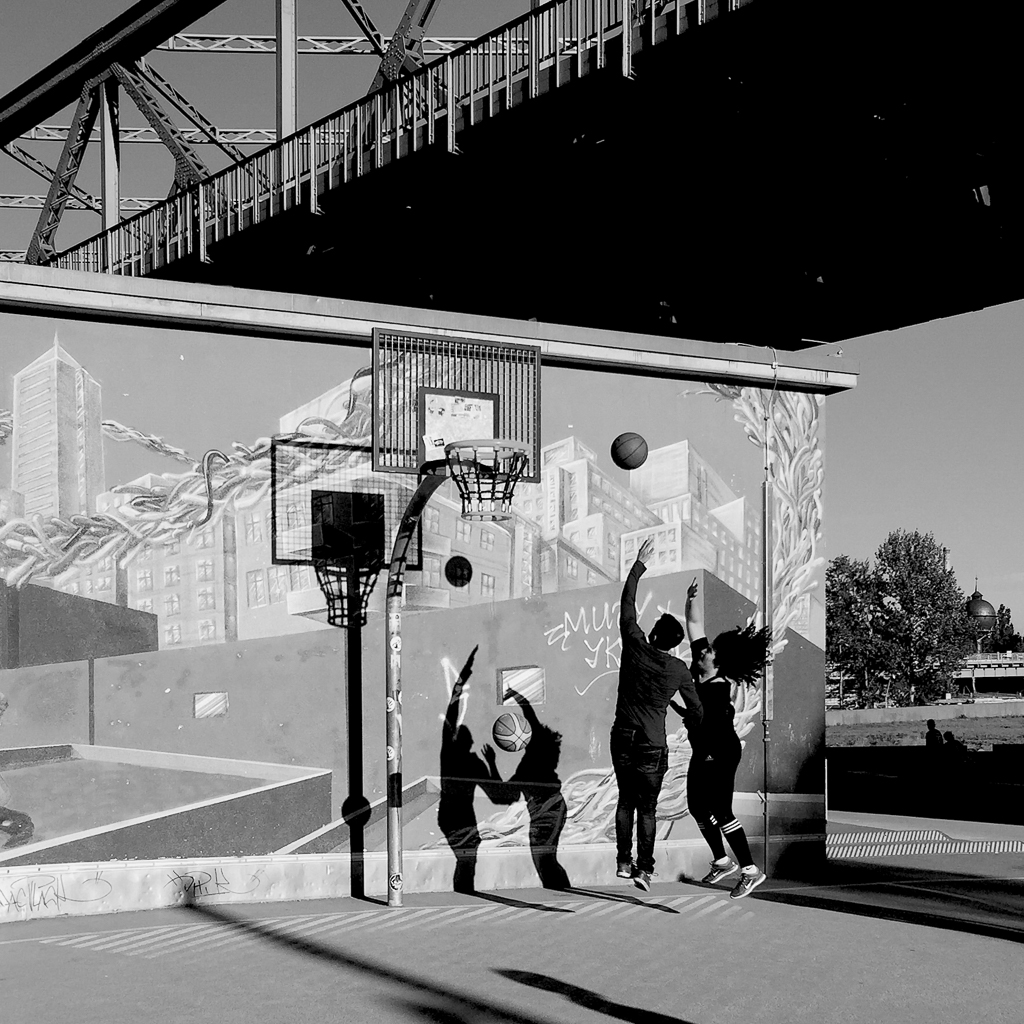
Who do you think is the audience for your work? Is this who you want your audience to be? What is it you hope to achieve, either on a personal or professional level, with your body of work?
At the moment, my audience is on Instagram, flickr, sometimes p1xels, Eyeem, 500px, and of course various groups on TheAppwhisperer. Also some of the blogs like mobiography, iphoneographycentral, etc. I have joined specific Facebook mobile photography groups in which the dialogue is stimulating and one gets to know the other photographers a little better. A goal is to eventually plan a themed project, print it and perhaps exhibit it. I have also given several workshops on iphoneography.
‘The Notch in his Shadow’ © Karen Axelrad
I sat on a bench just outside the walls of the old city of Jerusalem and waited for things to happen. The light wall, and bright evening sunlight were perfect to contrast with the men in black walking by. I took this with Hipstamatic using Americana Lens, and BlacKeys SuperGrain film
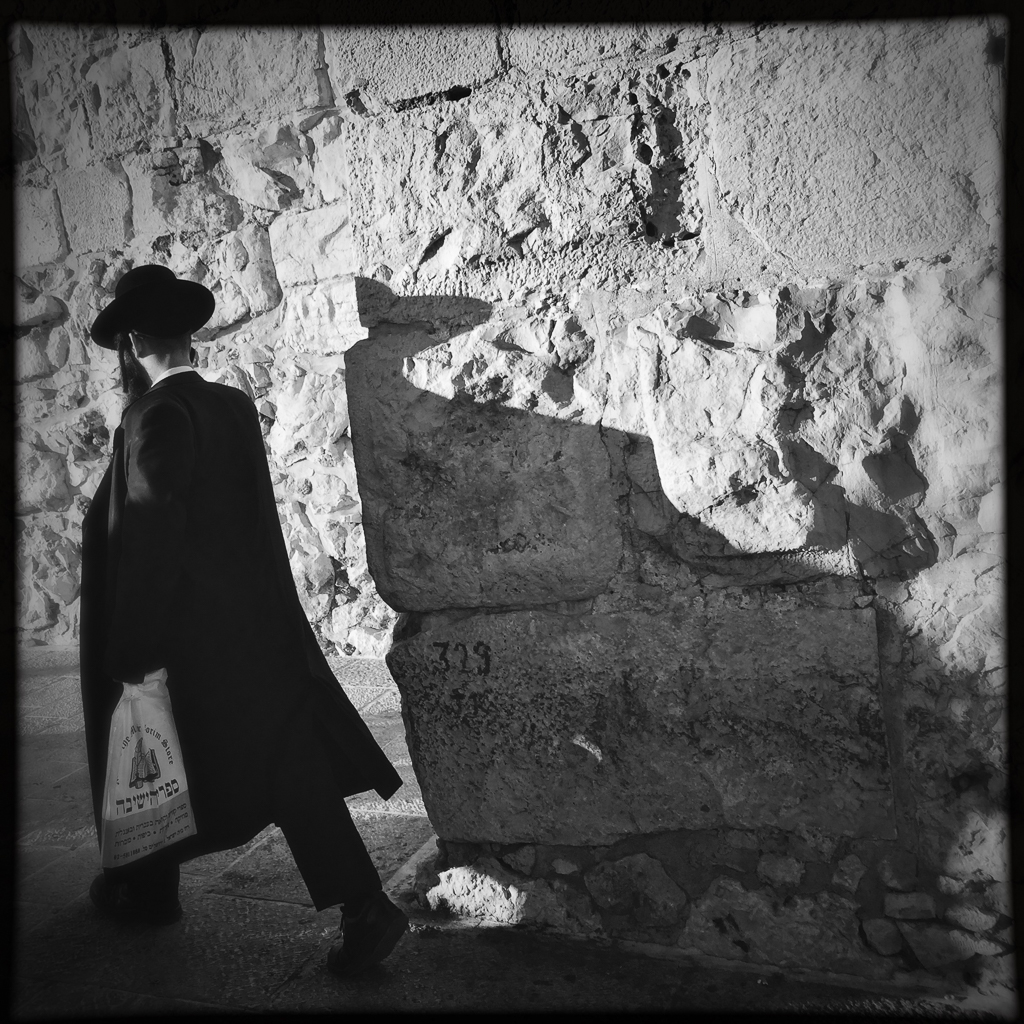
What do you think distinguishes your street photography from others in the group?
This is difficult because I don’t have a unified style in which others can immediately identify my work. I would like to eventually, but my curiosity and need to experiment probably preclude this.
‘The Couple’ © Karen Axelrad
I took many photos waiting for people to be framed by the archway in the religious city of Tzfat, Israel. This was processed with Snapseed
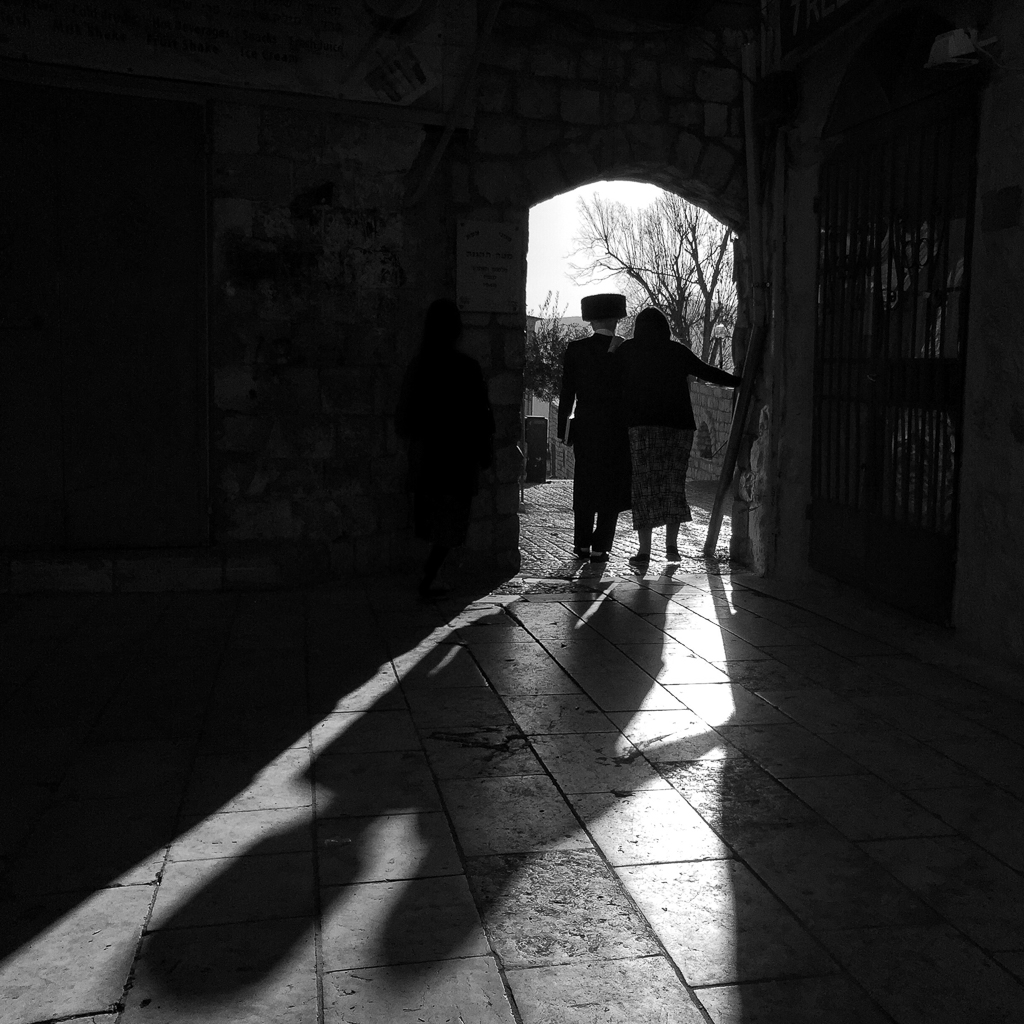
Where do you show your work? How has social media played a role in your photography? Which platforms are you most active on?
Originally, I was taking photos because I loved it, and the audience was irrelevant. But people “liking” a particular photo is a powerful incentive to continue providing for one’s “audience”. I have been on flickr for years with my dslr photos, but when I started focusing on mobile photography, Instagram and flickr became important platforms. It is always a thrill when a photo is picked up by flickr Explore and suddenly thousands of people are viewing a photo, or a particular group features one of my photos.
‘The Hurrying Shadow’ © Karen Axelrad
I waited until someone’s shadow was placed in the middle of the light. This was processed with Dramatic HD to produce a high contrast photo
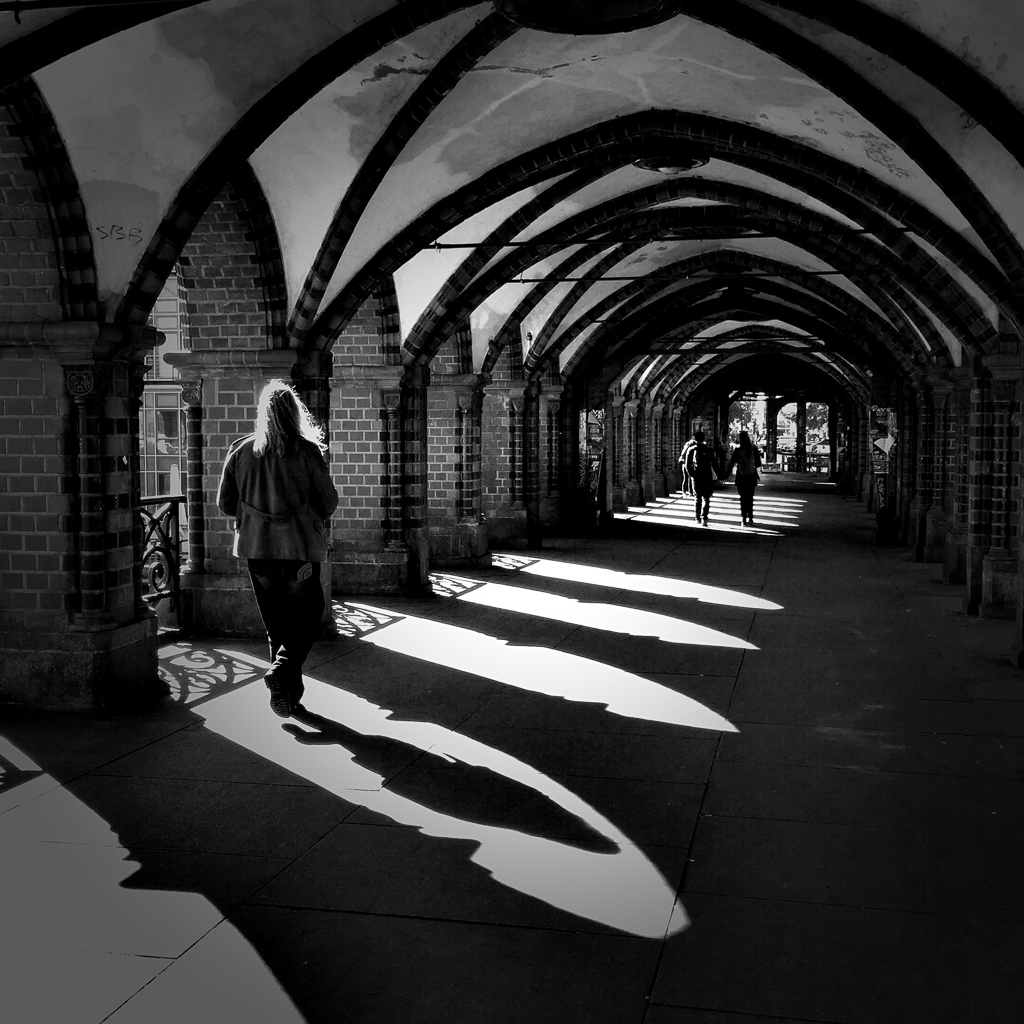
Do you have any tips that you would like to share with us? Is there anything else you would like to add?
When I first started doing mobile photography, I learned most from blogs in which not only good photos were posted, but people listed the apps they used. Having the best quality camera and lens used to be of great importance, but now I realise the iPhone has refined my ability to see and frame. The lines and the light are the most important elements no matter what camera one is using. I think it is much easier to take street photos with a smartphone because it is less intrusive than a big camera. In a very dark situation or indoors with children and low light, a camera with a flash is still a better choice. Practicing and taking lots of photos is the best teacher.
‘Beach Dog’ © Karen Axelrad
I waited until the figures were between the palm trees. This was taken in Laguna Beach, California and processed with Hipstamatic with John S lens, and BlacKeys SuperGrain film.
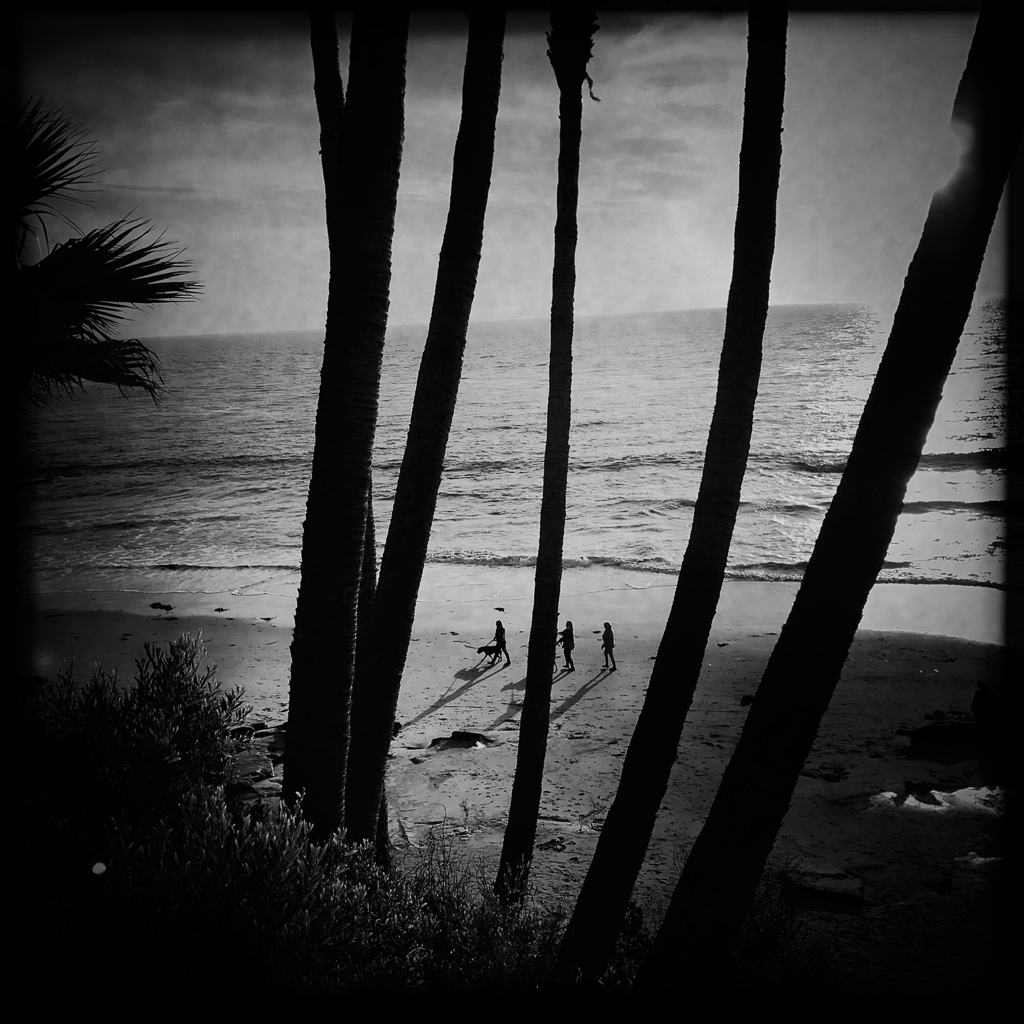
While you’re here…
….we have a small favour to ask. More people than ever are reading TheAppWhisperer.com and we could not be more excited about that. We bring you ad-free journalism every day, so you don’t have to close windows and be distracted with advertisements. We specialise in mobile photography and mobile art and we value all of our readers, writers, contributors and viewers but we do have costs and we do need to ask for your help. We at TheAppWhisperer spend many hours each day, each week and each month to bring you this high quality level of journalism. We do it because we are passionate about it and because we want others to be as passionate too.
If everyone who reads our website, who likes it, helps to support it, our future would be so much more secure. Please help us by offering a contribution or supporting us with a monthly donation of your choosing.
[seamless-donations]
